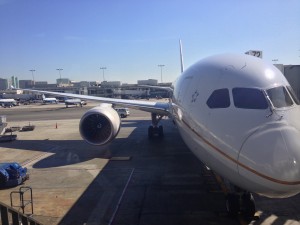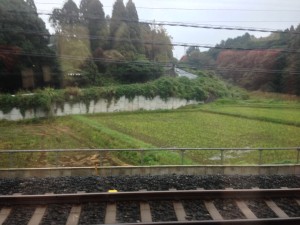This was the beginning of my ten-day trip to Japan. I had planned to travel with a friend who’d been to Japan before, but his availability evaporated about a month ahead of time.
So I went alone. No tour guide, no backup. Just me, my wallet, and a small suitcase of clothes.
I had two flights to Japan: one to Los Angeles International Airport (LAX), and another to Narita. The flight to LAX was perfectly, blissfully uneventful. I worried about finding my gate at the huge LAX with only an hour between flights. We landed, I disembarked the plane, and stared directly at the gate for the Narita flight. It was directly opposite; literally twenty feet from one waiting area to another.
The gate was filled with non-Japanese Asians. I assume Japan is the cheapest hub between California and, say, Singapore or Seoul.
So I waited for an hour, watching a bleary-eyed man order two cups of coffee, and promptly spill one all over his jeans.
 We then proceeded to board a 787 Dreamliner to Japan. It was a beautiful plane: roomy and comfortable, even in coach. They even gave each passenger a commemorative pack of playing cards.
We then proceeded to board a 787 Dreamliner to Japan. It was a beautiful plane: roomy and comfortable, even in coach. They even gave each passenger a commemorative pack of playing cards.
It’s a 13-hour flight from LAX to Narita. I slept fitfully, despite mild turbulence, and eventually gave up and flipped through the movie options. Thankfully, they had a wide variety of foreign films, all subtitled in English. I ended up watching a legitimately spooky Bollywood horror movie, Ek Thi Daayan, about Indian witches. Had a neat twist ending, too.
One advantage of a $1,500 plane ticket: the flight attendants fed us well, with mediocre but filling meals and snacks.
The plane touched down in Japan. I looked out the window eagerly, and I saw…an airport. Just like any other airport. I slumped back in my seat. I wanted this to be alien. I would have to wait.
I exited and looked around for two important things: an ATM and the Japan Rail desk. I needed the first so I could withdraw some yen for meals and such, and I needed the last for my Japan Rail Pass.
Quick spiel about the JR Pass, for those unfamiliar: Japan’s invested heavily in train infrastructure. The JR Pass gives you 7, 14, or 21 days of access to almost every rail line in Japan, including intra-city lines. However, to buy a JR Pass, you must purchase a voucher before your trip, receive it at home, take it with you to Japan, and trade it in for your actual JR Pass at a Japan Rail desk.
Narita Airport was full of Japanese, and lots of English. Every sign had English equivalents. So I headed through immigration–easy enough, despite the lone person processing non-Japanese visitors–and tried to find an ATM.
Fortunately, once I made it to the main concourse, I saw an ATM sign, and followed it to a couple of ATM machines. And sure enough, each one had an English button. Within a few minutes, I had 20,000 yen (about US$200) in my pocket, and I was looking around for the Japan Rail desk.
That was easy to find, too. I was beginning to feel that Japan was going to be easy. How wrong I was.
Getting the JR Pass was straightforward, though I had to stand in line for about 15 minutes to do so. Even so, as I approached the desk, a young woman in a uniform approached me and asked–in English!–if I was there for a JR Pass. I said, “yes,” and she guided me to the short form I needed to fill out.
At the desk, I got my JR Pass, and the clerk asked, “Where is your hotel?” I explained that I was staying in Tokyo, specifically Asakusa, and she asked me to wait for a moment. She printed out a train ticket for me, then pulled out a map and showed me the best route to Asakusa, which included two train lines and a subway ride. I later learned that this ticket was a special reserved seat on the super-express to Tokyo. She could have just let me take a regular train, which doesn’t require a ticket. How nice of her!
Following the English signs, I made my way to the train station, boarded the train, went to my seat…and it was occupied. I blinked, sat down next to the occupant, and looked at my ticket. I had arrived early, and I was on the previous train! Fortunately, the next stop was the other side of the terminal a few minutes away, so I hopped off and waited for my train.
As I waited, I looked around. About half a dozen people stood on this platform, waiting for the train. They were all Japanese. Zero ethnic diversity.
My train came, I hopped on board, and I settled in for a 1-hour train ride to Tokyo.
 The train zipped through tunnels for a few minutes, then exited to the outside…and suddenly I was in Japan. Rice paddies, dense forests, and quaint little villages surrounded the train as it hurtled towards the metropolis. I felt alone and a little homesick. I was in an alien world.
The train zipped through tunnels for a few minutes, then exited to the outside…and suddenly I was in Japan. Rice paddies, dense forests, and quaint little villages surrounded the train as it hurtled towards the metropolis. I felt alone and a little homesick. I was in an alien world.
The train arrived in Tokyo station, at which point I had to switch to another line. Again, everything was in English, so while I spent half an hour trying to find the right sign and the right line, at least I never got really lost.
I hopped on the Yamanote Line north to Ueno, which was only 4 stops away. The train passed through Akihabara, a fact which I filed away for later. Upon arriving in Ueno, I had to find the subway line to Asakusa. The subways require their own ticket (not covered by the JR Pass), but fortunately, the ticket machines all have English instructions, too.
I finally found myself at Asakusa Station. I wasn’t sure exactly how to get to my hotel from there, so I followed the signs for the Information Desk. Either I followed them incorrectly or they were poorly posted, because I followed them right up a staircase, out an exit, to the streets of Tokyo.
And I was on an alien planet.
It’s hard to describe just how different Japan is. I’ve visited Bermuda, Ireland, England, and South Africa. They’re all different than America. This was wildly different. There was no English anywhere. Even the iconography is different.
I turned 180 degrees and descended back into the station, found a clerk, and asked (in Japanese) where I could find my hotel. He said “Ah,” grabbed a paper map, and showed me, using some basic English.
I took a breath, re-ascended the stairs, and made my way to my hotel. A few blocks away, I found it. My heart swelled, I entered, and I found myself in a familiar environment: front desk, smiling staff, tiny restaurant off to one side; the works. I introduced myself, in English–I had deliberately chosen hotels where the staff could speak English–and soon had my room key. A few minutes later, I stepped into my room.
 This was a Japanese-style double room, which meant that it was barely wider than the double bed. But it was mine for 4 nights. I settled in and collapsed onto the bed.
This was a Japanese-style double room, which meant that it was barely wider than the double bed. But it was mine for 4 nights. I settled in and collapsed onto the bed.
I was in Japan.